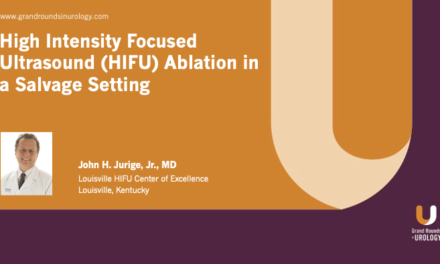Jim C. Hu, MD, MPH, presented “Overview of Image-Guided, Minimally-Invasive Focal Treatment” during the Virtual Global Summit on Precision Diagnosis and Treatment of Prostate Cancer in October 2020.
How to cite: Hu, Jim C. “Overview of Image-Guided, Minimally-Invasive Focal Treatment.” October 2020. Accessed Apr 2024. https://dev.grandroundsinurology.com/overview-of-image-guided-minimally-invasive-focal-treatment/
Overview of Image-Guided, Minimally-Invasive Focal Treatment – Summary
Jim C. Hu, MD, MPH, Director of the LeFrak Center for Robotic Surgery and the Ronald P. Lynch Chair in Urologic Oncology at Weill Cornell Medical College, reviews emerging data on patient selection and outcomes of focal therapy. He discusses results of recent studies examining high-intensity focused ultrasound (HIFU) and comparing it with cryoablation, and looks at cancer recurrence rates after focal therapy. Dr. Hu describes an exploratory study of in-office partial gland cryoablation, then discusses a current project, PC CONCEPT, which is evaluating focal therapy at a population level. He emphasizes that a significant number of men do not get a prostate biopsy during follow-up. Since 30-60% of men who do receive a follow-up biopsy are shown to have biopsy-proven cancer, there is concern that men who do not receive a biopsy at some point following treatment may have recurrent cancer and have missed a window of curability. Dr. Hu concludes by noting that functional outcome preservation is better with focal therapy than radical prostatectomy, with only a 1-2% risk of significant deterioration of urinary and sexual functioning. He also adds that volume and orientation changes after focal therapy can create significant challenges for accurate biopsy and surveillance.
The Virtual Global Summit on Precision Diagnosis and Treatment of Prostate Cancer brings together key international opinion leaders of every clinical subspecialty involved in patient care. This event is an integral part of the AdMeTech Foundation’s Annual Summit, which was established in 2016 and become seminal in shaping the state of the art and future vision for precision care. The goal of this event is three-fold: 1) Educating the key stakeholders; 2) Supporting a sustained cross-disciplinary dialogue and consensus on the best emerging clinical practices and research priorities; and 3) Expediting clinical adoption of promising novel diagnostics and therapeutics. For more educational activities from this virtual event, visit our collection page.






